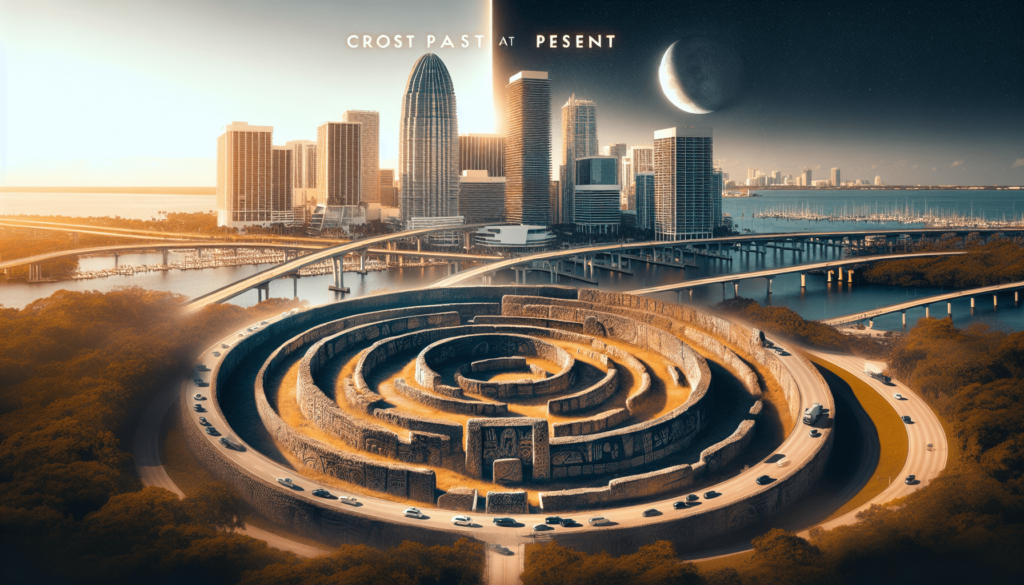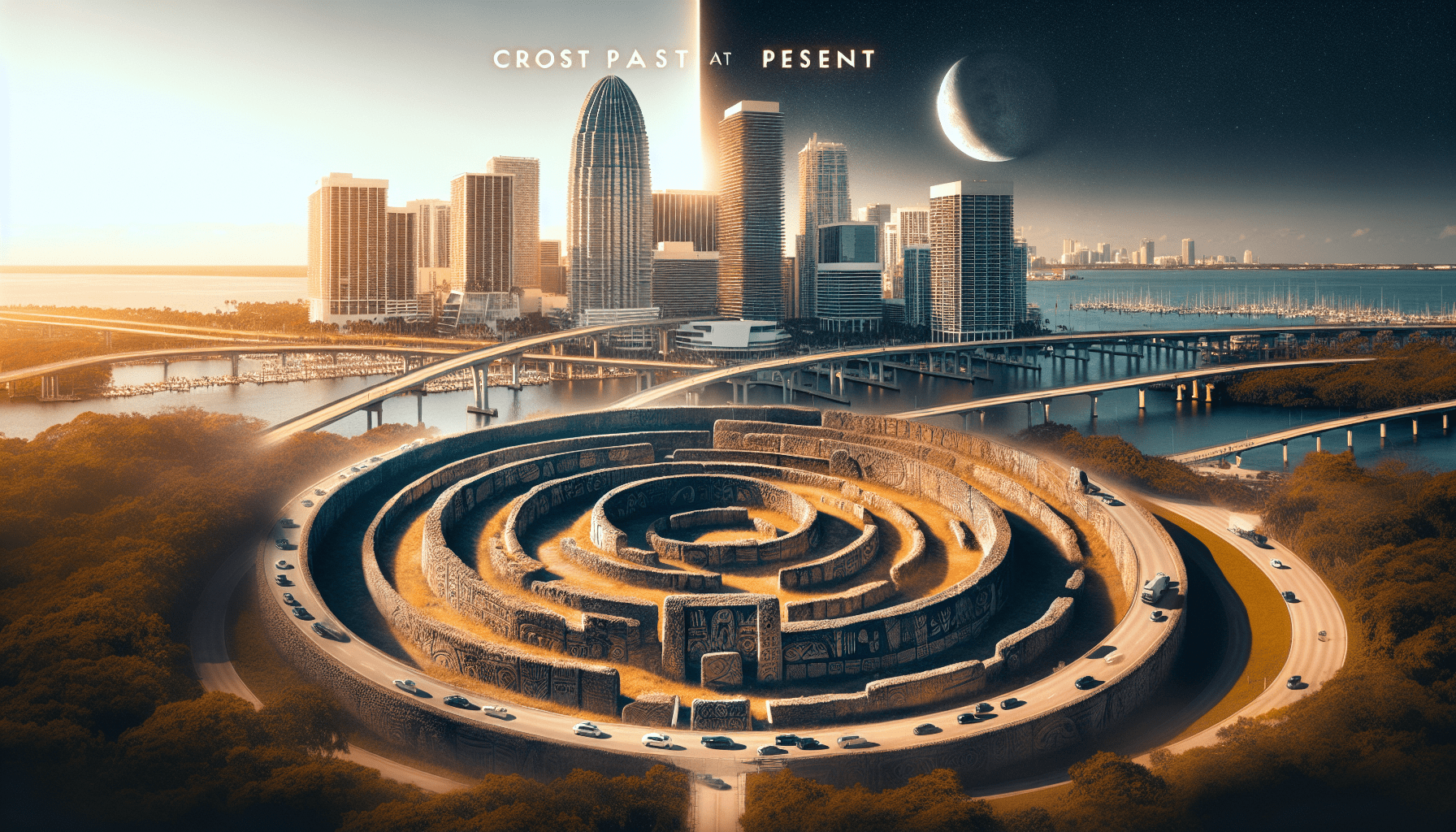SY COMPACT Travel Umbrella Windproof Automatic Umbrellas-Factory Outlet umbrella
$9.59 (as of November 22, 2024 15:26 GMT +00:00 - More infoProduct prices and availability are accurate as of the date/time indicated and are subject to change. Any price and availability information displayed on [relevant Amazon Site(s), as applicable] at the time of purchase will apply to the purchase of this product.)Imagine stepping into a site where history echoes through the very ground you walk on; that’s exactly what you’ll experience at the Miami Circle National Historic Landmark. Nestled at the mouth of the Miami River, this enigmatic archaeological treasure offers a glimpse into the lives of the Tequesta Native Americans who once inhabited the area. As you explore, you’ll not only bask in the beautiful views of Miami but also dive deep into a past that spans over 2,000 years. To make the most of your visit, consider brushing up on the site’s history, and don’t overlook those hidden gems that often go unnoticed by the casual observer. With various tours available, you’re sure to find one that suits your interest. To plan your visit, check for the most current operating hours and tour schedules. This landmark isn’t just another stop on your sightseeing adventure—it’s a journey into the heart of Miami’s ancient history.
Overview
Background
Imagine strolling through the bustling streets of modern Miami, a city alive with vibrant culture, towering skyscrapers, and the hum of urban life. Now, visualize stepping into a space that transports you thousands of years back into the past, to a time when ancient Native Americans inhabited the area. This isn’t just a figment of imagination but a reality at the Miami Circle National Historic Landmark, a prehistoric archeological site that offers a unique window into the early history of the region.
Significance
The Miami Circle is significant for several reasons. Firstly, it’s one of the few physical evidences of pre-Columbian Native American structures in an urban area in the United States. Its discovery provided invaluable insights into the Tequesta tribe, a group of Native Americans that once thrived in South Florida. The site’s preservation amidst Miami’s rapid development highlights the importance of protecting historical artifacts. Its status as a National Historic Landmark underscores its cultural and historical importance not just to Miami but to the nation as a whole.
Location
Nestled at the mouth of the Miami River in the heart of downtown Miami, the Miami Circle offers a stark contrast to its modern surroundings. Located at 401 Brickell Avenue, it’s easily accessible and serves as a serene escape from the hustle and bustle of city life, allowing visitors to step back in time and connect with Miami’s ancient past.
History
Discovery
The Miami Circle was uncovered quite by accident in 1998 during a routine archaeological survey as part of a development project. What appeared initially as an assortment of odd markings and holes in the bedrock, soon revealed itself to be a perfect circle measuring 38 feet in diameter with 24 holes carved into the limestone.
Excavation
Following the discovery, a comprehensive excavation was undertaken. Artefacts and samples were meticulously catalogued, revealing an array of objects that provided a glimpse into the lives of the site’s ancient inhabitants. The excavation became a race against time, balancing the need for scientific study with the pressures of urban development.
Interpretation
The interpretation of the Miami Circle has led to various theories regarding its purpose and origins. Most scholars agree that it was likely a structure of significant spiritual and ceremonial importance to the Tequesta tribe. Some suggest it could have served as the foundation for a larger building, while others see it as an astronomical observatory or a marker of seasonal cycles.

Archaeological Site
Features
The most striking feature of the Miami Circle is, undoubtedly, its circular arrangement of holes and basins carved into the bedrock. This enigmatic design is complemented by the site’s location, which offers panoramic views of the Miami River and Biscayne Bay, reinforcing theories about its ceremonial significance.
Artifacts
The excavation of the site unearthed a treasure trove of artifacts, including tools made from shell and bone, pottery shards, and remnants of plant and animal food sources. These findings have provided scholars with valuable insights into the daily lives, diets, and culinary practices of the Tequesta people.
Preservation
The preservation of the Miami Circle has been a testament to the collaborative efforts of archaeologists, historians, government agencies, and the local community. Recognizing the site’s historic value, steps were taken to safeguard it from urban development, ensuring that this window into Florida’s ancient past remains open to future generations.
Visiting Miami Circle
Opening Hours
The Miami Circle National Historic Landmark is open to the public year-round, offering visitors the chance to experience this historical gem amidst the backdrop of Miami’s vibrant cityscape.
Admission Fees
Admission to the Miami Circle is free, making it an accessible attraction for everyone interested in delving into Miami’s ancient history.
Guided Tours
For those keen on gaining deeper insights into the history and significance of the site, guided tours are available. These tours provide not just a narrative of the site’s discovery and excavation but also an interpretation of its historical context and its role in the broader narrative of the region’s past.

Nearby Attractions
Brickell Key
Just a short walk from the Miami Circle, Brickell Key offers a picturesque blend of luxury living, upscale amenities, and green spaces. The island is perfect for a leisurely stroll, with stunning views of the Miami skyline and the bay.
Bayfront Park
Bayfront Park is a lush urban oasis in the heart of downtown Miami. With its sweeping views of Biscayne Bay, a variety of sculptures, and the iconic Pepper Fountain, it offers a peaceful retreat from the city’s hustle and bustle.
Vizcaya Museum and Gardens
A bit further afield but worth the trip, Vizcaya Museum and Gardens is a stunning early 20th-century estate offering a glimpse into Miami’s Gilded Age history. The Italian Renaissance-style villa and its beautifully landscaped gardens are a testament to the city’s rich cultural heritage.
Tips for Visitors
Plan Your Visit in Advance
To make the most of your visit, it’s a good idea to plan in advance. Check the weather forecast, and consider combining your visit with other nearby attractions to maximize your experience.
Wear Comfortable Shoes and Clothes
Given the outdoor nature of the site, comfortable shoes and clothes are a must. Be prepared for Miami’s warm climate and occasional rain showers, especially during the summer months.
Bring Water and Sun Protection
Staying hydrated and protected from the sun is crucial, especially if you’re planning to explore the site and surrounding areas on foot. Bring a water bottle and don’t forget your sunscreen, hat, and sunglasses.
Interesting Facts
Ancient Native American Origin
The Miami Circle is a profound reminder of Florida’s ancient history, predating European contact. Its discovery sheds light on the Tequesta tribe’s sophisticated culture and their deep connection to the land.
Mysterious Purpose
The exact purpose of the Miami Circle remains a mystery, sparking curiosity and intrigue amongst historians, archaeologists, and visitors alike. This element of mystery adds to the site’s allure and appeal.
Impact on Miami’s History
The preservation of the Miami Circle has had a significant impact on Miami’s historical landscape, serving as a catalyst for greater appreciation and protection of the city’s cultural heritage.
Further Resources
Official Website
For the most current information on visiting hours, guided tours, and special events, the official website of the Miami Circle is an invaluable resource.
Address and Contact Information
The Miami Circle National Historic Landmark is located at 401 Brickell Avenue, Miami, FL. For inquiries, the site’s managing agency or local tourist information centers can provide assistance.
Additional Reading
For those interested in delving deeper into the history and significance of the Miami Circle, a wealth of books, articles, and academic papers are available, offering diverse perspectives on this fascinating archaeological site.
Conclusion
Appreciating Miami Circle
A visit to the Miami Circle offers an opportunity to connect with a part of Miami’s history that often goes unnoticed amidst the city’s modern-day allure. It’s a reminder of the rich tapestry of cultures and histories that have shaped not only Miami but also the broader narrative of human settlement in North America.
Preserving the Past
The story of the Miami Circle is one of discovery, preservation, and education. It underscores the importance of safeguarding historical sites, not just for their academic or cultural value, but for their ability to inspire and educate future generations about the depth and diversity of human history. As you walk away from the Miami Circle, it’s this appreciation of the past, and the role it plays in informing our present and future, that you carry with you.







